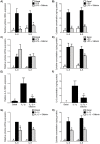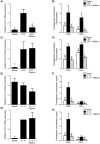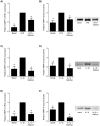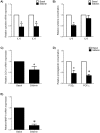Effect of silibinin in reducing inflammatory pathways in in vitro and in vivo models of infection-induced preterm birth
- PMID: 24647589
- PMCID: PMC3960267
- DOI: 10.1371/journal.pone.0092505
Effect of silibinin in reducing inflammatory pathways in in vitro and in vivo models of infection-induced preterm birth
Abstract
Infection-induced preterm birth is the largest cause of infant death and of neurological disabilities in survivors. Silibinin, from milk thistle, exerts potent anti-inflammatory activities in non-gestational tissues. The aims of this study were to determine the effect of silibinin on pro-inflammatory mediators in (i) human fetal membranes and myometrium treated with bacterial endotoxin lipopolysaccharide (LPS) or the pro-inflammatory cytokine IL-1β, and (ii) in preterm fetal membranes with active infection. The effect of silibinin on infection induced inflammation and brain injury in pregnant mice was also assessed. Fetal membranes and myometrium (tissue explants and primary cells) were treated with 200 μM silibinin in the presence or absence of 10 μg/ml LPS or 1 ng/ml IL-1β. C57BL/6 mice were injected with 70 mg/kg silibinin with or without 50 μg LPS on embryonic day 16. Fetal brains were collected after 6 h. In human fetal membranes, silibinin significantly decreased LPS-stimulated expression of IL-6 and IL-8, COX-2, and prostaglandins PGE2 and PGF2α. In primary amnion and myometrial cells, silibinin also decreased IL-1β-induced MMP-9 expression. Preterm fetal membranes with active infection treated with silibinin showed a decrease in IL-6, IL-8 and MMP-9 expression. Fetal brains from mice treated with silibinin showed a significant decrease in LPS-induced IL-8 and ninjurin, a marker of brain injury. Our study demonstrates that silibinin can reduce infection and inflammation-induced pro-labour mediators in human fetal membranes and myometrium. Excitingly, the in vivo results indicate a protective effect of silibinin on infection-induced brain injury in a mouse model of preterm birth.
Conflict of interest statement
Figures





Similar articles
-
The citrus flavone nobiletin reduces pro-inflammatory and pro-labour mediators in fetal membranes and myometrium: implications for preterm birth.PLoS One. 2014 Sep 19;9(9):e108390. doi: 10.1371/journal.pone.0108390. eCollection 2014. PLoS One. 2014. PMID: 25238390 Free PMC article.
-
Dietary phytophenols curcumin, naringenin and apigenin reduce infection-induced inflammatory and contractile pathways in human placenta, foetal membranes and myometrium.Mol Hum Reprod. 2013 Jul;19(7):451-62. doi: 10.1093/molehr/gat015. Epub 2013 Mar 7. Mol Hum Reprod. 2013. PMID: 23475986
-
Inhibition of PIM1 kinase attenuates inflammation-induced pro-labour mediators in human foetal membranes in vitro.Mol Hum Reprod. 2017 Jun 1;23(6):428-440. doi: 10.1093/molehr/gax013. Mol Hum Reprod. 2017. PMID: 28333279
-
The Therapeutic Effect of Silymarin and Silibinin on Depression and Anxiety Disorders and Possible Mechanism in the Brain: A Systematic Review.Cent Nerv Syst Agents Med Chem. 2023;23(2):86-94. doi: 10.2174/1871524923666230823094403. Cent Nerv Syst Agents Med Chem. 2023. PMID: 37612866
-
The Radioprotective Potentials of Silymarin/Silibinin Against Radiotherapy- Induced Toxicities: A Systematic Review of Clinical and Experimental Studies.Curr Med Chem. 2023;30(33):3775-3797. doi: 10.2174/0929867330666221124155339. Curr Med Chem. 2023. PMID: 36424777
Cited by
-
Flavonoids, the Family of Plant-Derived Antioxidants Making Inroads into Novel Therapeutic Design Against Ionizing Radiation-Induced Oxidative Stress in Parkinson's Disease.Curr Neuropharmacol. 2022;20(2):324-343. doi: 10.2174/1570159X19666210524152817. Curr Neuropharmacol. 2022. PMID: 34030619 Free PMC article. Review.
-
Silibinin attenuates adipose tissue inflammation and reverses obesity and its complications in diet-induced obesity model in mice.BMC Pharmacol Toxicol. 2020 Jan 23;21(1):8. doi: 10.1186/s40360-020-0385-8. BMC Pharmacol Toxicol. 2020. PMID: 31973745 Free PMC article.
-
Silymarin and Inflammation: Food for Thoughts.Antioxidants (Basel). 2024 Jan 14;13(1):98. doi: 10.3390/antiox13010098. Antioxidants (Basel). 2024. PMID: 38247522 Free PMC article. Review.
-
Silibinin attenuates methotrexate-induced pulmonary injury by targeting oxidative stress.Exp Ther Med. 2015 Aug;10(2):503-507. doi: 10.3892/etm.2015.2542. Epub 2015 Jun 3. Exp Ther Med. 2015. PMID: 26622344 Free PMC article.
-
Fetal membrane architecture, aging and inflammation in pregnancy and parturition.Placenta. 2019 Apr;79:40-45. doi: 10.1016/j.placenta.2018.11.003. Epub 2018 Nov 10. Placenta. 2019. PMID: 30454905 Free PMC article. Review.
References
-
- Yoon BH, Romero R, Moon JB, Shim SS, Kim M, et al. (2001) Clinical significance of intra-amniotic inflammation in patients with preterm labor and intact membranes. Am J Obstet Gynecol 185: 1130–1136. - PubMed
-
- Menon R, Fortunato SJ (2007) Infection and the role of inflammation in preterm premature rupture of the membranes. Best Pract Res Clin Obstet Gynaecol 21: 467–478. - PubMed
Publication types
MeSH terms
Substances
LinkOut - more resources
Full Text Sources
Other Literature Sources
Research Materials
Miscellaneous

